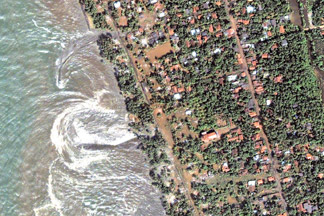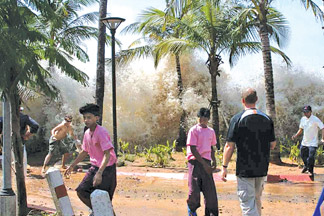Lanka geared to face a tsunami
By Dhaneshi YATAWARA
In 1994, South Africa renamed December 26, the Boxing Day as the Day
of Goodwill. Around the world, this day comes following the Christmas
resembling happiness and giving with a holiday spirit. On 2004, in Sri
Lanka this day was expected to be like this, yet unexpectedly ended up
in a disaster. It would be the most horrific natural disasters we as a
country have encountered in the recent past.
 |
|
GSMB Chairman
Dr. N.P. Wijeyananda |
Ironically, the earthquake that triggered the tsunami is recorded to
be the most powerful earthquake in 40 years erupted under the Indian
Ocean near Sumatra. The angry giant waves crashed ashore in many
countries including Sri Lanka killing thousands of people.
Waves as high as six metres crashed in to coastal villages, sweeping
away people, cars and even a fully boarded train that was bound
downsouth. It killed nearly 30,000 children, women and men, displacing
almost 25 million people. This bitter learned lesson made Sri Lanka take
a different turn in disaster management. Until recent times, Sri Lanka
almost totally depended on global and regional centres for seismic (
earthquake related) and tsunami information and warnings. Yet, today
through the Geological Survey and Mines Bureau (GSMB) the first attempts
are to be made to issue local seismic and tsunami bulletins based on
seismic information issued by global and regional centres.
Pacific Tsunami Warning Centre in Hawaii, West Coast/Alaska Tsunami
Warning Centre in the Pacific Ocean and the Japanese Meteorological
Agency are the international tsunami warning centres which Sri Lanka
gathers the information. Several regional centres also give the input -
namely the Malaysian Meteorological Department, Thai Meteorological
Department, Meteorological, Climatological and Geophysical Agency in
Indonesia.
The present implementation is to locally re-calculate and analyse the
information issued from these centres and evaluate its effect to us. So
far, we have taken the regionally issued warnings as it is rather
re-calculating. "Recently there was an announcement for evacuation
issued to our region on an earthquake that could cause a tsunami and
thus Sri Lankan authorities with great effort evacuated the people from
the southern coastal line.
Signal
At the end it was found that there was no affect to Sri Lanka but it
affected Indonesia. So this gave us a signal that we need a system to
re-calculate the regionally issued information according to our facts
and see the actual affect on Sri Lanka. This is implementing a system
which was not available by then," said Chairman of the GSMB Dr. N.P.
Wijeyananda.
Speaking to the 'Sunday Observer' Dr. Wijeyananda said that the
system is continuing their exercises in inter department level, being
ready to act at any necessary time. "In this system we will issue the
predictions as well as suggest the necessary action," he said. This
information will be issued to relevant implementing institutes such as
the Disaster Management Centres and Meteorological Department etc. The
information will be sent to the media as well as it can play a major
role in mass communication. "At the moment the information will be
through e-mails," Dr. Wijeyananda explained.
 |
|
Satellite image of
tsunami in Kalutara |
 |
|
The 2004 tsunami
hitting a coastal city in Japan |
According to the geophysicists at the GSMB the international and
regionally issued bulletins always highlight that each country should
re-analyse the actual effect of their predictions.
The bulletin that will be issued by the GSMB, under the new system
will be a recalculation based on the data issued regionally of an
earthquake in the sea, thus the suggestive actions will be of three
levels - i.e. Wait till the next bulletin with updates, warning and
evacuation.
Threat
If the present bulletin issued by international and regional centres
do not show any threat to Sri Lanka, the authorities need to wait until
the next set of information is updated from those centres.
Sometimes this calculations would indicate only a tsunami warning to
Sri Lanka though the regional warning may say evacuation is needed. And
evacuation comes as the last option.
"Evacuation is a very complicated process. People are not at equal
levels and special attention is needed by those who are old, sick as
well as children and costs.
Thus it is essential for us to re-calculate and see the actual
situation of the disaster Sri Lanka may face, as the international
centres predict," Dr. Wijeyananda said.
This bulletin is issued as an advice to relevant Government agencies.
Under the Sri Lankan administration it is only the national and local
government agencies that have the authority to make decisions regarding
the official state of alert in their area and actions to be taken in
response. The most challenging part for the scientists involved in this
would be facing the physical changes of nature of the natural disasters.
Adapting to the changes would be the challenge of the Government.
Believing in the evergreen rule that nature is far superior and powerful
than the human earth dweller, would be the key safety fact we all should
adhere to.
|

